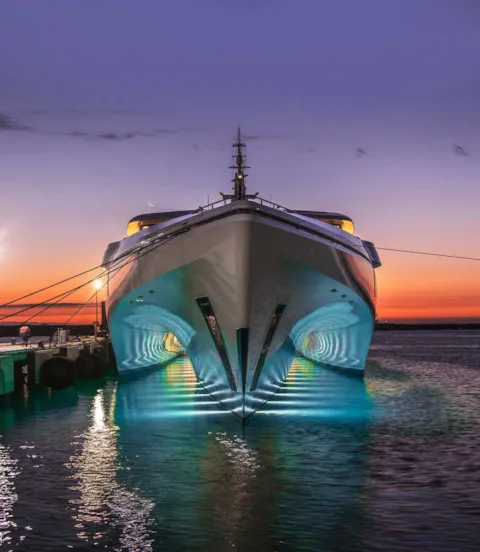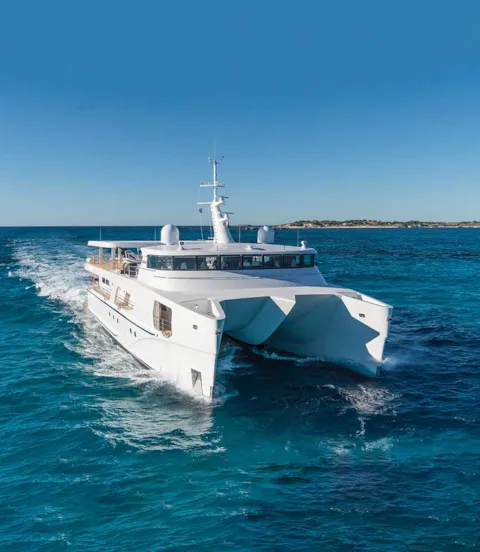Superyacht in aluminium
Australia is unique in many ways, and so is its yacht building industry. A can-do attitude, paired with the local availability of very specific skillsets, was what enabled DNV GL customer Echo Marine to build the world’s largest aluminium trimaran luxury superyacht.
Aluminium isn’t necessarily the first material a superyacht designer would think of when planning the next hull. But there are folks down under who wouldn’t choose anything else under any circumstances. No wonder, Australia being the world’s top producer of bauxite, and a leading producer of aluminium. The state of Western Australia is the nation’s main mining area, and Henderson, a suburb of the state capital Perth on the west coast, is home to the Australian Marine Complex, an industrial cluster mainly dedicated to shipbuilding. This is where Echo Marine Group builds super yachts, ferries, offshore service vessels and other ships.

A challenging task
Echo Director Mark Stothard proudly counts down the merits of his company’s latest major achievement, the 2,940 GT, 84 metre trimaran superyacht White Rabbit Golf: The largest all-aluminium yacht ever built in the world, the largest trimaran superyacht ever built in the world, and the largest superyacht ever built in Australia. “I‘ve been in this business since the late 1970s and have seen the industry evolve, and it has been an amazing journey. This is the most successful build I‘ve ever been involved in,” Stothard says about the White Rabbit.
Her owner, who resides in Singapore and wishes to remain anonymous, is a longstanding client of Echo, says Stothard. “He sat us down about three months into the project and said: ‘Boys, I want to challenge you with engineering boldness in this project. What is really important to me is that it is a really smooth vessel, a very quiet vessel, and I want you to explore all engineering solutions that will achieve that goal for me.’” Echo’s engineering partner was One2Three Naval Architects, and Sam Sorgiovanni was in charge of the interior and exterior styling.
One2Three were the natural choice of naval architect given their experience with the owner’s previous 60m trimaran White Rabbit Echo as well as their successful portfolio of innovative catamaran and trimaran projects and their ability to ensure challenging engineering requests result in successful, robust and practical outcomes. One2Three’s Managing Director Steve Quigley says, “We didn’t think twice when recommending DNV GL as the classification society of choice to the owner and shipyard because of our long-standing relationship and proven track record in bringing ambitious engineering challenges to fruition together as a team. DNV GL’s Sydney-based approval team worked extremely closely with our designers throughout the design and build and we are grateful for their flexible approach to the novel solutions presented and their thoroughness and integrity.”

A matter of skill in aluminium
“People tend to forget that the world’s very first aluminium vessel was built here in Western Australia,” says Stothard. “So we are way ahead of the game in that respect. Companies here have built a lot of big structures and many aluminium vessels hundred metres and longer. We ourselves have been in the game since the late 70s and early 80s. Of course steel has its place in the market of heavy-displacement hulls, but you can do a fair share of what is customarily done in steel in aluminium just as well. It amazes me that the perception of aluminium being a difficult material is still out there. The oldest boat built out of aluminium in Western Australia is 60 years old, and it is still going. Show me a steel boat that is going that well at that age.”
“We are long time advocates”, says DNV GL’s Tim Holt when asked about his view of aluminium as a material for a large superyacht. “Working in aluminium is an entirely different skill set from working in steel. This is exactly why Western Australia is doing well in this field, because it has got that expertise. The skill set has grown over decades.”
The reality about aluminium is, if you weld it and fabricate it properly and work with the class society to make sure none of the plates can work too much between the stringers and frames, if you insulate it well below the waterline and make sure you don’t get any sweating, and if you have a good cathodic current protection system, you’re going to be all right. I wouldn’t consider building a boat in any other material than aluminium because it is just so easy to work with, it lasts ‒ it’s a fabulous material. And I can stand by that statement as I am half owner of the well known 50m aluminium luxury cruise vessel True North.

Exceptional efficiency
But there is much more to White Rabbit than its aluminium trimaran hull. “One of the incredible things about this boat is its beam of nearly 20 metres,” says Stothard. “Add to that the quietness, the smoothness, the efficiency. We definitely have broken some barriers down with it. The noisiest part emits only 42 DBA, which is very little; the boat is dead smooth, amazingly manoeuvrable, and efficient; we got 5,000 kilowatts of power available on board in total, including running the house, and we achieved a speed of 18.7 knots at a reasonable load. An equivalent steel superyacht of the same volume ‒ approximately 3,000 gross tonnes ‒ which we saw in Monaco had twice the kilowatts on board just for the propulsion to do the same speed. That is impressive in itself.”
The owner was especially pleased with the excellent seakeeping and fuel efficiency of the unique One2Three hull shape and design, Stothard stresses: “He was absolutely over the moon. And with the efficiency comes a green aspect. I believe this is the most efficient vessel of its class as a superyacht – it literally has half the horsepower to do the same speed as other vessels, and that means half the fuel. I think the industry is gradually beginning to see the benefits of a multihull design.”
Not to mention the features that make the White Rabbit a luxury superyacht: Palatial accommodation and leisure spaces on board, a jacuzzi pool, underwater lights, a gym and spa, a swimming platform and a sun deck, and above all, a fabulous, 46-metre ‘shadow boat’ or support yacht called Charley, likewise built by Echo and delivered two years before White Rabbit. Charley has a fibreglass catamaran hull, making it the largest composite resin-infused vessel built in Australia to date. “We pulled five tonnes of resin through one half of the hull within two hours,” reports Stothard. Another record Echo Yachts is proud of.
DNV GL approved the structural drawings and issued a hull construction certificate for the craft. Charley carries all the extra equipment and ‘toys’ for the passengers of White Rabbit: a 12-metre catamaran tender with a special launch platform, an armada of smaller tenders, jet skis and fun craft, a hovercraft. The top deck doubles as a helipad, there is a decompression chamber on board as well as a dive store and a sonar system for searching out wreck dives.

Managing complexity together
This double project was doubtlessly highly complex, not just because of the design and manufacturing challenges but also in terms of coordination. Experience and being able to rely on a large team of skilled workers and a network of proven partners were key to this success, says Stothard. “DNV GL had a lot to do with it, and they went far beyond the call of duty,” he points out. “DNV GL verified the strength of the hulls making sure the hulls survive in the sea states required. White Rabbit is capable of operating in sea states six metres high, Charley not as much. The hydro analysis along with the FEM model verification was one of the biggest aspects of that.”
Working with class means evolving together, says the director of Echo Marine. “The class tells you what works and what doesn’t. You might start building a 30-metre boat together, then you go from there into the 40s and 50s, and on it goes. It doesn’t make sense to reinvent the wheel and work with different partners all the time. It makes much more sense to go on the journey together.”
- Key image - Echo Yachts
- Side image 2 - Echo Yachts
- Side image 3 - Echo Yachts

